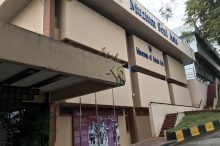Museum of Asian Art, University of Malaya, Malaysia

 The Museum of Asian Art (Muzium Seni Asia) is located within University of Malaya, Malaysia's first and oldest university, in the heart of Kuala Lumpur.
With its new approach, "Three Civilizations under One Roof", the outstanding education-oriented museum is a treasure trove of local and Asian art objects. The museum has collected various types of cultural artifacts from the Malay and Islamic region, Chinese pottery and Indian religious sculptures.
The Museum of Asian Art, University of Malaya, has three flors of exhibition space, and holds nearly 8,000 treasures, representing cultures from throughout Asia and spanning 4,000 years of Asian history. Featuring 1500 square feet of gallery space, it showcases the unique material, aesthetic and intellectual achievement of Asian art and culture, including ceramics from Thailand, Viet Nam, Japan and Iran, textiles from the Malay archipelago and the sacred masks of Orang Asli (Aboriginal people) communities.
The Museum of Asian Art (Muzium Seni Asia) is located within University of Malaya, Malaysia's first and oldest university, in the heart of Kuala Lumpur.
With its new approach, "Three Civilizations under One Roof", the outstanding education-oriented museum is a treasure trove of local and Asian art objects. The museum has collected various types of cultural artifacts from the Malay and Islamic region, Chinese pottery and Indian religious sculptures.
The Museum of Asian Art, University of Malaya, has three flors of exhibition space, and holds nearly 8,000 treasures, representing cultures from throughout Asia and spanning 4,000 years of Asian history. Featuring 1500 square feet of gallery space, it showcases the unique material, aesthetic and intellectual achievement of Asian art and culture, including ceramics from Thailand, Viet Nam, Japan and Iran, textiles from the Malay archipelago and the sacred masks of Orang Asli (Aboriginal people) communities.
History
The collection of the Museum of Asian Art has a long history, having been built over a period of almost 50 years. The first item on record is a bronze Buddha head from the Chiengsen period (1400-1550 AD), Thailand, given to the museum by Kun Krassri Nimanamhasminda in 1954. This contribution marked the beginning of the University of Malaya Art Museum, at that time based in the university’s campus in Singapore. The Buddha head was thus acquired several years before the University of Malaya campus was established in Kuala Lumpur in 1962. At that time a section of the university library was used to display the artifacts. The museum’s present home was built to accommodate the increasing new acquisitions. In June 1980, the new building was built in the scenic area between the Faculty of Economics and the Law Faculty (currently occupied by the Business and Accounting Faculty). Within its three floors of exhibition space, the museum represents three civilisations: the Indian, The Chinese and the Islamic. The Museum plans to give online access to its artifacts very soon. At the same time, collaboration with many faculties and museum institutions within Malaysia and other countries is underway. The museum's collections are also open to researchers.Permanent collections
The museum currently holds one of the most comprehensive collections of Asian art in the region. It includes 7500 artifacts in its collection, about 2000 of which are Chinese ceramics, a further 2500 Asian ceramics, with the rest being ethnographic items from Orang Asli, Malay, various local ethnic and Indonesian textiles. The extensive water vessel (kendi) collection is the largest in the world with pieces dating from the 11th century A.D. The museum also houses many rare pieces such as the Sawankhalok pottery manhunt elephant figurines produced in Thailand during 14th-15th century A.D. The valuable collections of stone carvings, copper items, Malays' weaponry among others are also on display as part of the university duties to provide its students and country with a message - our ancestors passing a great civilization to us.View all Asia-Europe Museum Network (ASEMUS) members in Malaysia
Similar content
07 Mar 2016
posted on
10 Mar 2012
09 Oct 2016
from - to
01 Mar 2013 - 30 Jun 2013
posted on
01 Feb 2012
17 Sep 2014
